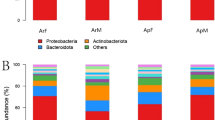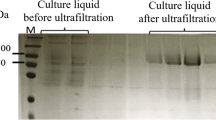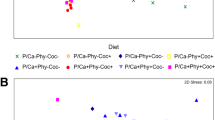Abstract
Artificial diet was developed for rearing of lower termites (workers) Coptotermes formosanus. C. formosanus was fed with either wood powder of Japanese red pine, cellulose, cellobiose, or glucose for 30 days. The effect of carbon sources in the diet on the structure and function of the symbiotic intestinal microbial community and on the physiological activity of C. formosanus was studied. Three symbiont protozoa, Pseudotrichonympha grassi, Holomastigotoides hartmanni, and Spirotrichonympha leidyi, were found in the hindgut of C. formosanus that fed on the diets containing carbon sources with high molecular weight (MW). However, when artificial diets containing carbohydrate with low MW were used, both P. grassi and H. hartmanni disappeared, and only few S. leidyi were alive. This suggested that both P. grassi and H. hartmanni play important roles in the digestion and utilization of carbohydrate with high MW. The denaturing gradient gel electrophoresis analysis of bacterial community in the hindgut of termites showed that the similarity between intestinal bacteria community in termites fed with diets containing high-MW carbon sources and those with low MW was only about 40%. It was apparent that changes in diets resulted to changes in intestinal microbial community, and this in turn affected cellulase activity in C. formosanus.








Similar content being viewed by others
References
Ahmadjian V, Jacobs JB (1981) Relationship between fungus and alga in the lichen Cladonia cristatella Tuck. Nature 289:169–172
Altschul SF, Gish W, Miller W, Myers EW, Lipman DJ (1990) Basic local alignment search tool. J Mol Biol 215:403–410
Altschul SF, Madden TL, Schaffer AA, Zhang J, Zhang Z, Miller W, Lipman DJ (1997) Gapped BLAST and PSI-BLAST: a new generation of protein database each programs. Nucleic Acids Res 25:3389–3402
Amann RI, Ludwig W, Schleifer KH (1995) Phylogenetic identification and in situ detection of individual microbial cells without cultivation. Microbiol Rev 59:143–169
Breznak JA (1982) Intestinal microbiota of termites and other xylophagous insects. Annu Rev Microbiol 36:323–343
Broderick NA, Raffa KF, Goodman RM, Handelsman J (2004) Census of bacterial community on the gypsy moth larval midgut by using culturing and culture-independent methods. Appl Environ Microbiol 70:293–300
Dubois M, Gilles KA, Hamilton JK, Rebers PA, Smith F (1956) Colorimetric method for determination of sugars and related substances. Anal Chem 28:350–356
Eichner CA, Erb RW, Timmis KN, Wagner-Dobler I (1999) Thermal gradient gel electrophoresis analysis of bioprotection from pollutant shocks in the activated sludge microbial community. Appl Environ Microbiol 62:102–109
Hirsch AM, Lum MR, Downie JA (2001) What makes the rhizobia–legume symbiosis so special? Plant Physiol 127:1484–1492
Inoue T, Murashima K, Azuma J, Sugimoto A, Slaytor M (1997) Cellulose and xylan utilization in the lower termite Reticulitermes speratus. J Insect Physiol 43:235–242
Itakura S, Ueshima K, Tanaka H, Enoki A (1995) Degradation of wood components by subterranean termite, Coptotermes formosanus Shiraki. Mokuzai Gakkaishi 41:580–586
Kyou K, Watanabe T, Yoshimura T, Takahashi M (1996) Lignin modification by termite and its symbiotic protozoa. Wood Res 83:50–54
Muyzer G, de Waal EC, Uitterlinden AG (1993) Profiling of complex microbial populations by denaturing gradient gel electrophoresis analysis of polymerase chain reaction-amplified genes coding for 16S rRNA. Appl Environ Microbiol 59:695–700
Ohkuma M (2003) Termite symbiotic systems: efficient bio-recycling of lignocellulose. Appl Microbiol Biotechnol 61:1–9
Ogino A, Koshikawa H, Nakahara T, Uchiyama H (2001) Succession of microbial communities during a biostimulation process as evaluated by DGGE and clone library analyses. J Appl Microbiol 91:625–635
Saito N, Nei M (1987) The neighbor-joining method: a new method for reconstructing phylogenetic trees. Mol Biol Evol 4:406–425
Santo Domingo JW, Kaufman MG, Klug MJ, Holben WE, Harris D, Tiedje M (1998) Influence of diet on the structure and function of the bacterial hindgut community of crickets. Mol Ecol 7:761–767
Sekiguchi H, Watanabe M, Nakahara T, Xu B, Uchiyama H (2002) Succession of bacterial community structure along the Changjiang River determined by denaturing gradient gel electrophoresis and clone library analysis. Appl Environ Microbiol 68:5142–5150
Sorensen T (1948) A method of establishing groups of equal amplitude in plant sociology based on similarity of species content. Biol Skr (Cph) 4:1–34
Tanaka H, Nakanishi M, Ogbonna JC, Ashihara Y, Yajima M (1993) Development of apparatus for cultivation of anaerobic microorganisms. Biotechnol Tech 7:189–192
Thompson JD, Higgins DG, Gibson TJ (1994) CLUSTAL W: improving the sensitivity of progressive multiple sequence alignment through sequence weighting, position-specific gap penalties and weight matrix choice. Nucleic Acids Res 22:4673–4680
Trager W (1934) The cultivation of a cellulose-digesting flagellate, Trichomonas termopsidis, and of certain other termite protozoa. Biol Bull 66:182–190
van der Heijden MGA, Klironomos JN, Ursic M, Moutoglis P, Streitwolf-Engel R, Boller T, Wiemken A, Sanders IR (1998) Mycorrhizal fungal diversity determines plant biodiversity, ecosystem variability and productivity. Nature 396:69–72
Watanabe H, Tokuda G (2001) Animal cellulases. Cell Mol Life Sci 58:1167–1178
Watanabe H, Nakamura M, Tokuda G, Yamaoka I, Scrivener AM, Noda H (1997) Site of secretion and properties of endogenous endo-b-1,4-glucanase components from Reticulitermes speratus (Kolbe), a Japanese subterranean termite. Insect Biochem Mol Biol 27:305–313
Watanabe H, Noda H, Tokuda G, Lo N (1998) A cellulase gene of termite origin. Nature 394:330–331
Yamaoka I (1979) Selective ingestion of food by termite protozoa, Trichonympha agilis. Zoo Mag 88:174–179
Yamaoka I, Nagatani Y (1975) Cellulose digestion system in termite, Reticulitermes speratus (Kolbe). I. Producing site and physiological significance of two kinds of cellulase in the worker. Zoo Mag 84:23–29
Yamaoka I, Nagatani Y (1977) Cellulose digestion system in termite, Reticulitermes speratus (Kolbe). II. Ultra structural changes related to the ingestion and digestion of cellulose by flagellate, Trichonympha agilis. Zoo Mag 86:34–42
Yoshimura T, Azuma J, Tsunoda K, Takahashi M (1993a) Cellulose metabolism of the symbiotic protozoa in termite, Coptotermes formosanus Shiraki (Isoptera: Rhinotermitidae). I. Effect of degree of polymerization of cellulose. Mokuzai Gakkaishi 39:221–226
Yoshimura T, Azuma J, Tsunoda K, Takahashi M (1993b) Cellulose metabolism of the symbiotic protozoa in termite, Coptotermes formosanus Shiraki (Isoptera: Rhinotermitidae). II. Selective defaunation of protozoa and its effect on cellulose metabolism. Mokuzai Gakkaishi 39:227–230
Acknowledgements
This study was supported in part by a Grant-in-Aid for Scientific Research A (no. 16208017) from the Japan Society for the Promotion of Science (JSPS), a Grant-in-Aid for Exploratory Research (no. 16651032), and The 21st Century COE Program from the Ministry of Education, Culture Sports, Science and Technology (MEXT).
Author information
Authors and Affiliations
Corresponding author
Additional information
An erratum to this article can be found at http://dx.doi.org/10.1007/s00253-006-0415-5
Rights and permissions
About this article
Cite this article
Tanaka, H., Aoyagi, H., Shina, S. et al. Influence of the diet components on the symbiotic microorganisms community in hindgut of Coptotermes formosanus Shiraki. Appl Microbiol Biotechnol 71, 907–917 (2006). https://doi.org/10.1007/s00253-005-0215-3
Received:
Revised:
Accepted:
Published:
Issue Date:
DOI: https://doi.org/10.1007/s00253-005-0215-3




